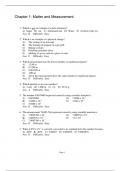Class notes
ARMA Model - Stata Lab Session Notes
- Course
- Institution
Here are the notes from the ARMA Model Lab session. The document includes all the steps with the explanation attached. There are 8 steps. 1 - Looking to the data, 2 - Looking at the autocorrelation plot, 3 - Estimate ARMA models, 4 - Construct residuals and check if there is autocorrelation, 5 - C...
[Show more]





